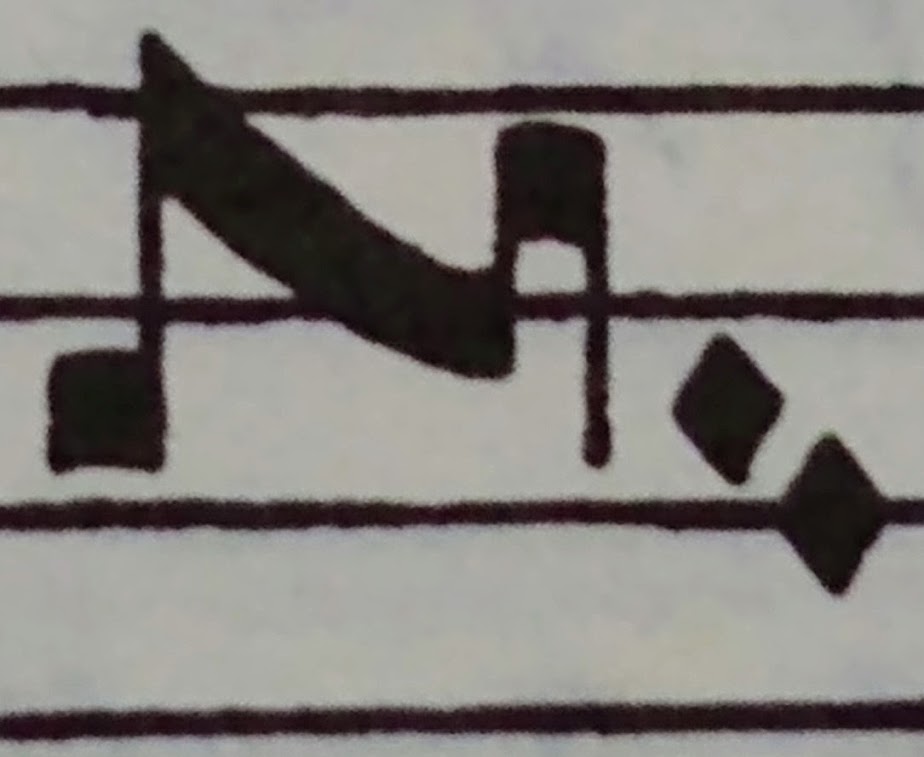Graduale Novum torculus resupinus subbipunctis
-
How do I create this neume in GABC? The example is from the offertory Recordare. (gjhiGF) is what I'm going with until I figure out how to do it.


 torculus resupinus subbipunctis.jpg924 x 757 - 53K
torculus resupinus subbipunctis.jpg924 x 757 - 53K -
Unfortunately, I wasn't able to recreate this neume... (gjh!ivGF) is the closest I get, missing the elegant line from j to h.Thanked by 1madorganist
-
(g@jh@iGF) produces the right shape, but the fourth note is missing the right stem. I'm stumped on this one!Thanked by 1smvanroode
-
At any rate, the Graduale Novum construction is curious in light of the adiastematic neumes of the manuscripts. A torculus resupinus looks nothing like what we see in E, or in SG339, SG376, SG342, or in Bamberg, a complex neume that centers on sol, echoing the two sols of "mei," which precedes "Domine." To bring that out, one would need something like (-gjhig/f!GF!D).

 from OF Recordare.pdf13KThanked by 1madorganist
from OF Recordare.pdf13KThanked by 1madorganist -
E has a c over all of the long notes of the neume, which is reproduced in St. Gall 376; nonetheless, I think Dó(gjhqiGF__gvFD_0)mi(d_0!ewfd)ne(d_) would be a reasonable interpretation of the St. Gall notation when the various sources are taken into consideration. I'm curious about your use of the initio debilis. Is it because the neume begins in unison with the previous note, or is there another reason? I was mainly concerned with the typography itself and how to reproduce it, but I value this discussion as well!
-
Now we are at it, this is how Gregor und Taube represents the neume, which is much like Royce interpreted the adiastematic neumes.

 Schermafbeelding 2020-12-05 om 09.48.57.png384 x 295 - 33KThanked by 1Ralph Bednarz
Schermafbeelding 2020-12-05 om 09.48.57.png384 x 295 - 33KThanked by 1Ralph Bednarz -
In using initio debilis at the start of "Domine," I was imagining what I would do for an interpretive, performance edition of the score. Two reasons for its use. First, to show that it's the second sol of the neume, not the first, that governs the syllable "Do-", and second, because "mei" is the strongest word in the phrase "Recordare mei, Domine." Sol seems to be the modal tenor or dominant here, and the melody of "Domine" is a kind of flourish flowing out of "mei," rather than "mei" being a preparation for "Domine."
Welcome to the MusicaSacra Forum!
To participate in the discussions on Catholic church music, sign in or register as a forum member, The forum is a project of the Church Music Association of America.
Categories
- All Discussions21,105
- General Music Discussion8,218
- Job Openings197
- Management of Music Programs850
- Choral Matters533
- Church Documents and Rubrics524
- CMAA Notes302
- Events716
- For Newcomers: Read First26
- Sacred Polyphony546
- Hymnody872
- Gregorian Chant: General2,697
- ↳ Graduale Romanum and Liber Usualis368
- ↳ Graduale Simplex60
- ↳ Semiology63
- Vernacular Plainsong696
- Anglican Use and Anglican Chant68
- Organ, Other Instruments and Repertoire435
- New Composition/Works in Progress1,290
- Recordings230
- Music for Hispanic Ministry159
- Music Education: Children211
- Music Education: General222
- News Items245
- Positions Wanted2
- General Discussion: Catholicism739
- Amusements177
- General Discussion1,033
- Opinions117

